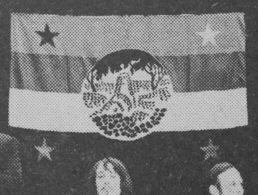 image
by M. Schmöger, 27 Mar 2004
image
by M. Schmöger, 27 Mar 2004

Last modified: 2025-01-11 by bruce berry
Keywords: zimbabwe | zanu | zapu | super-zapu | mdc | rf | uanc |
Links: FOTW homepage |
search |
disclaimer and copyright |
write us |
mirrors
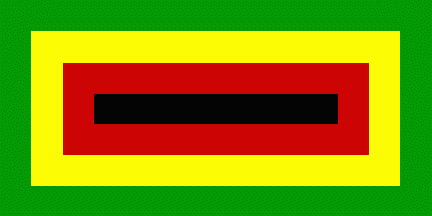 image
by Randy Young, 26 Jan 1999
image
by Randy Young, 26 Jan 1999
This is the flag of the current ruling party in Zimbabwe, based on the
description given to me by Bruce Berry: "The flag of the ruling Zimbabwe African
National Union - Patriotic Front (ZANU-PF) in Zimbabwe consists of a series
of concentric rectangle stripes which are from the outside moving in towards
the centre: green, gold, red, and black (as in the colours of the Zimbabwe
flag). For example, the green stripe borders all sides of the flag, followed
by a yellow stripe and so on until there is a solid black rectangle in
the centre. Each stripe is of equal width (as in the Zimbabwe flag) and
the flag is 1:2. The Zimbabwe flag is based directly on the colours of
ZANU-PF and the symbolism of the colours is the same."
Randy Young, 21 Jan 1999
Some years ago I received from Michael Faul, then membership secretary of The Flag Institute and a former citizen of Rhodesia/Zimbabwe, colour drawings of the flags of four political parties of Zimbabwe used in the 1980 independence election. There were five flags, one for ZAPU used before the election, and one for ZAPU (PF) used during the election. (ZANU and ZAPU formed a coalition called the Patriotic Front, and both parties used the PF after their names. ZANU, the ruling party since 1980, is still known as ZANU-PF).
The flag Mr. Faul shows as being used by ZAPU-PF in the 1980 election is the same as that described and illustrated earlier, with a yellow vertical bar, and black/red/green horizontal bars, al with different coloured stars. However, unlike the description and illustration previously provided to this list which shows a red star on the black stripe, Mr. Faul's drawing has a white star on the black stripe. The red star would have been consistent with the older ZAPU flag described by Bruce Berry (four stripes, red/green/yellow/black, with black and yellow stars at hoist and fly of the red stripe, and red and green star at hoist and fly of black stripe, with a badge in centre showing the Great Zimbabwe ruins).
I asked Mr. Faul about this, and he affirms that the flags he saw in
Zimbabwe during the 1980 election used the white star on the black bar.
He also noted that he never saw an actual flag, but representations of
the flag printed on political posters and T-shirts.
Devereaux D. Cannon, 20 Mar 2001
![[ZAPU flag]](../images/z/zw}zapu.gif) image
by António Martins-Tuválkin, 14 Mar 2001
image
by António Martins-Tuválkin, 14 Mar 2001
In "Nations Without States" (James Minahan, 1996) states that the
party flag of the former ZAPU (Zimbabwe African People's Union) is the one used
as a flag by the Ndebele people of Matabeleland with a description given by Minahan as
it being a horizontal tricolour with a vertical
stripe along the hoist. This vertical hoist stripe is yellow, with a black
5-pointed star. The three horizontal stripes are black with a red 5-pointed
star; red with a green 5-pointed star; and green with a yellow 5-pointed
star. In each case the star is shown as centered, and almost but not quite
touching the top and bottom of the stripe (or left and right edge in the
case of the vertical stripe of course). Overall the flag's ratio is shown
as 2:3, and the width of the vertical stripe equals the height of one of
the horizontal stripes (based only on observation of the line drawing,
specifications not given).
Ned Smith, 14 Mar 2001
The flag used by the Zimbabwe African People's Union (ZAPU) during the liberation struggle against the minority-regime in Rhodesia in the 1970s is not the same as that described by Ned Smith as being used by the Ndebele in Zimbabwe. ZAPU was headed by the late Joshua Nkomo and had a guerrilla force know as the Zimbabwe People's Revolutionary Army (ZIPRA) which operated mainly from bases in Zambia. ZAPU, together with the Zimbabwe National People's Union (ZANU) led by Robert Mugabe and its forces known as the Zimbabwe National African Liberation Army (ZANLA) which operated mainly from Mozambique, formed a political alliance known as the Patriotic Front (PF). At the time of the pre-independence elections in 1980, the parties spilt into their respective factions as ZANU-PF and PF-ZAPU. ZAPU was predominantly Ndebele (from the south and west of the country) and ZANU was predominantly Shona. The Shona comprise approximately 80% of the population and hence it was not surprising that ZANU-PF won the elections. In December 1987 a Unity Accord was signed between the two parties whereby ZAPU was incorporated into ZANU-PF and Joshua Nkomo became one of two vice-presidents of Zimbabwe.
The flag used by ZAPU during the 1970s comprised four horizontal stripes
of red, green, yellow and black. In the centre was a representation
of the Great Zimbabwe Ruins in black within a circle on a white/beige background.
There were also four five-pointed stars - one at each corner of the flag.
These were also in black, yellow, red and green. This flag was also used
by the ZIPRA forces and was rarely seen following independence in 1980.
It was certainly not used after the Unity Accord in December 1987 when
ZAPU, to all intents and purposes, ceased to exist as a separate political
entity.
Bruce Berry, 15 Mar 2001
As far I know, the new ZAPU flag adopted at end of 1979 or in 1980 was used in Matabeland in 1982-1986, when Nkomo broke with Mugabe, and liberated zones were created in two provinces of Matabeleland. As party flags, the upper star is reported white in Flagmaster. 1986 reconciliation took effect and ZAPU was absorbed into ZANU-PF in 1987. During 1987-1988 Super-ZAPU operated in Matabeleland, sponsored by South Africa, which opposed the government of Robert Mugabe. I don't have any knowledge of its flag, but given its covert nature, it is unlikely to have had one.
Revolutionary flags:
UANC (Bishop Abel Muzorewa) two successive flags (before 1979 and after 1979)
ZANU and ZANLA (concentric rectangles, several versions reported)
ZAPU and ZIPRA, as indicated by Bruce Berry. The arrangement of the stars
is not clear. Flagmaster
reported yellow near hoist and black in fly but I believe that is the single
source for this, rest say black in hoist in yellow in fly. Mainly sources
give green star near hoist and red in fly (I don't know any source that
gives red star near hoist)
Patriotic Front 197?-1979 (I don't know if a single unified flag exist)
Party flags
ZANU-PF after 1979. Unknown but perhaps same as before.
ZAPU-PF, as reported by Minahan 1979/80-1987 (white upper star according
Flagmaster)
Jaume Ollé, 25 Mar 2001
Yesterday I saw a CD cover for the CD "Survival" by Bob Marley &
The Wailers. The cover contains 49 flags (which all appear to be
African countries except for Papua New Guinea). Several of the flags
are older versions (the CD dates from 1990), but there was one that I could
not identify. It is divided horizontally with even stripes of red-green-yellow-black.
Going clockwise in the corners from upper left are stars, yellow-black-red-green.
In the center is a white disk with a black image I could not identify.
Michael Smuda, 08 Aug 2001
This is the flag of ZAPU - the Zimbabwe African People's Union - during
the 1970s.
Ned Smith, 09 Aug 2001
 image
by M. Schmöger, 27 Mar 2004
image
by M. Schmöger, 27 Mar 2004
During some recent research into German political flags I came across an
article in DKP (German Communist Party), "Unsere Zeit" of 17 February
1975 about a "tribunal against colonialism and apartheid" which had been held in
Bonn (Germany) and where the above flag was shown. Participants at the meeting were from
the liberation movements from South Africa, Namibia and
Zimbabwe: ANC, SWAPO, ZANU and ZAPU.
M. Schmöger, 27 Mar 2004
This flag of ZAPU (Zimbabwe African Peoples Union) is shown in The Flag Institute Bulletin
(No. 005 dated 01August 1978) and in an article in the Czech Vexilologie
journal (No.18 dated March 1976) by Pavel Fojtik and Jaroslav Martykan on the "Flags of
Freedom". It is also discussed in other vexillological bulletins such as Vexillinfo by
R.Baert and Flaggenmitteilung by G.Mattern.
The flag is composed of horizontal stripes (from top to bottom) of red, green, yellow and
black and stars (from a star at a staff above, clockwise) of yellow, black, green and
red. In the centre on a white circle is a stylized image of the ruins
of ancient Zimbabwe in black and two black trees.
Mikhail Revnivtsev, 28 Mar 2004
I know the sources quoted but I believe the central circle is yellow and not
white. The order of the stars I believe is (starting from the upper hoist corner, clockwise) black, yellow, red and green.
Jaume Ollé, 29 Mar 2004
Yes, in Vexilologie No. 18 (p. 233) the central disc is described as yellow.
In the Flag Institute Bulletin No. 005 (sheet 4) colour of this disk was not specified.
In the German (GDR) magazine Urania I saw in 1970 it shows a white disk.
Again, in Vexilologie No. 18 (p.233) the order of the arrangement of the colour
of the stars on the flag is
as indicated by Jaume Ollé. But again, in The Flag Institute Bulletin No. 005 (sheet 4) and
Urania, the colours are given as yellow, black, green and red.
This is probably because the flag was never officially authorised and variations
occurred
during manufacture.
Mikhail Revnivtsev, 30 Mar 2004
Several flags have been mentioned for ZAPU. Prior to independence ZAPU used the
four-stripe flag with an image of the Great Zimbabwe ruins as shown above.
A second design, with the same colours, was used later: The pattern is curiously
similar to the Boer Vierkleur flags (a 2:3
horizontal tricolor with a vertical stripe near the hoist: (2+2+2):(2+7), with
one star centered on each stripe.
On 14 March 2001, Ned Smith reported from [mnh96] «a horizontal tricolor with a
vertical stripe along the hoist. This vertical hoist stripe is yellow, with a
black 5-pointed star. The three horizontal stripes are black with a red
5-pointed star; red with a green 5-pointed star; and green with a yellow
5-pointed star. In each case the star is shown as centered, and almost but not
quite touching the top and bottom of the stripe (or left and right edge in the
case of the vertical stripe of course). Overall the flag's ratio is shown as
2:3, and the width of the vertical stripe equals the height of one of the
horizontal stripes» (this comes from our page).
 image by António Martins-Tuválkin, 09 Dec 2005
image by António Martins-Tuválkin, 09 Dec 2005
On 25 Mar 2001, Jaume Ollé (also edited in our page) wrote that "Flagmaster
reported yellow near hoist and black in fly but I believe that is the single
source for this» (though a week earlier, Ned Smith reported a different source for
this design: [mnh96]), the "rest say black in
hoist in yellow in fly."
 image by António Martins-Tuválkin, 09 Dec 2005
image by António Martins-Tuválkin, 09 Dec 2005
On 25 Mar 2001, Jaume Ollé wrote "Many sources give green star near hoist and
red in fly (I don't know any source that gives red star near hoist)".
Now I'm totally confused: Is this a third design, or just star colour specs for
the previously described ones? Which star goes on which stripe in which
source?
António MARTINS-Tuválkin, 09 Dec 2005
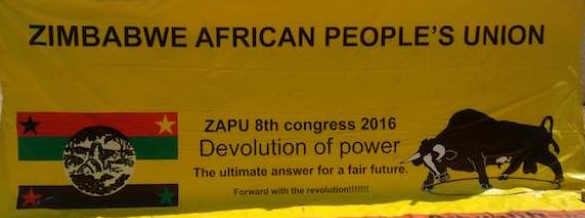 image sent by Bruce Berry, 19 Oct 2016
image sent by Bruce Berry, 19 Oct 2016
A poster
advertising the party's 2016 congress clearly shows the flag with the stars
arrangement of the stars being black (in the canton), yellow (in the upper fly)
on the upper red stripe and the red star (lower hoist) and green star (lower
fly) being on the bottom black stripe.
Bruce Berry, 19 Oct 2016
In December 2008, a group of former party members decided to leave
ZANU-PF and re-establish ZAPU. This was done at the
party congress on 16 May 2009 when the congress formally endorsed the party's
withdrawal from ZANU-PF. The current party Constitution describes the party flag
as it was used prior to the 1987 merger, but with an error - the green field is
omitted from the description, although it is still on the flag, as can be seen
in various photos of party activities. So this omission must have been an error.
Tomislav Todorović, 14 Jan 2023
In 1982 Nkomo and Mugabe quarreled. Nkomo is a member of the Ndebele tribe
while Mugabe is a Shona. The Ndebele revolted in Matabeleland in support of Nkomo
and some liberated zones were created in two provinces. It seems that the
ZAPU flag was used. In 1986 Nkomo and Mugabe re-established ties and the Unity
Accord was signed between ZAPU and ZANU. During 1987 and 1988 a group
called Super-ZAPU operated in Matabeleland (base of the Ndebele tribe)
with assistance from South Africa against the Zimbabwe government.
Jaume Ollé, 12 Dec 1998
Yes, it is true that there was a movement called "Super-ZAPU", which
was supported by the apartheid regime in South Africa against the Mugabe
government in Zimbabwe in the 1980s. This support would have been along the same lines
as the support given to Renamo in Mozambique against
Frelimo and was part
of the "destabilisation" efforts of the former South African government
in southern Africa. I am not aware of any flag used by Super-ZAPU. Unlike Renamo, the movement
did not survive for long and the "Unity Accord" between ZAPU and ZANU saw
Nkomo and Mugabe patch up their differences and the two political parties
merged and Nkomo became Vice President of Zimbabwe. Numerically the Ndebele
only account for 20% of the population of Zimbabwe, so they are unlikely
to be more than a minority political force
Bruce Berry, 14 Dec 1998
![[Movement for Democratic Change]](../images/z/zw}mdc.gif) image
by Zach Harden, 17 Mar 2002
image
by Zach Harden, 17 Mar 2002
The Movement for Democratic Change, or the MDC, is the official opposition
which contested the recent
parliamentary and presidential elections in Zimbabwe. Even though they lost, their
flag has been seen across the country. The flag is in a 1:2 ratio, the same as the national flag of
Zimbabwe.
The colour of red, black, green and yellow are present because those
colors not only derive from the national flag, but are the traditional colours of the Africa. The open hand on the flag is the election symbol
of the MDC and it represents transparency. It is holding nothing,
hiding nothing, showing commitment to change in Zimbabwe. The flag was shown in a Yahoo News Photo covering the elections.
Zach Harden, 17 Mar 2002
![[MDC logo]](../images/z/zw})mdc.gif) image sent by Zach Harden, 17 Mar 2002
image sent by Zach Harden, 17 Mar 2002
The open hand, the election symbol of the Movement for Democratic Change,
was chosen as it represents transparency : We have nothing to hide,
we carry no weapons and we promote the ideals of a peaceful democracy.
In addition it illustrates that each one of us has the power to change
the current political status quo in Zimbabwe. We have that power in our
hand and we can exercise it when we vote in this year's elections.
Our Slogan: In Shona - "Chinja Maitiro, Maitiro Chinja". In Ndebele
- "Guqula Izenzo, Izenzo Guqula".
The closest English translation is; "Now is the time, fight for
change, support the Movement"
Info from the MDC
website.
Zach Harden, 17 Mar 2002
 image
sent by
Edwards Maseko, 08 Sept 2007
image
sent by
Edwards Maseko, 08 Sept 2007
Originally reported on our sister mailing list, Russovex - by the member
from Latvia, the website at:
http://www.mthwakazionline.org/Editors.html
shows the statement by the movement for the creation of the break-away state
containing Matabeleland and Midlands parts of Zimbabwe for the Ndebele
people called the United Mthwakazi Republic.
This page shows the purported emblem and flag of the movement, while the flag
and detailed description of the symbols and colours is displayed at
http://mthwakazionline.org/Flag.html as shown above.
The flag of Mthwakazi contains a very unusual colour - gray.
Chrystian Kretowicz, 15 Nov 2005
 from
http://www.mthwakazionline.org/index.html
from
http://www.mthwakazionline.org/index.html
Mr. Ilmârs Bite from Latvia posted on Russovex mailing list yet another flag of
the Mthwakazi Republic (Matabeleland). The flag can be seen at:
http://www.mthwakazionline.org/index.html.
Chrystian Kretowicz, 22 Dec 2005
1. Stars: They represent light at night. They symbolise determination in the
face of adversity.
2. Sun: Represents daylight. It symbolises our civilisation, our goodwill.
3. Blue: Represents the vast expanse of the blue sky. It represents the infinity
of our hopes and dreams.
4. Grey: Represents our land and grey rainy clouds and symbolises the harmony of
our land and the rain that feeds it; the wisdom of our ancestors and the
infinity of our future.
5. Red: Represents blood and symbolises the blood of our fallen heroes.
The Mthwakazi Peoples Convention held two Conferences on the 21st and 28th
January 2006 where it was agreed:
1. That the nation of Mthwakazi seek secession from present-day Zimbabwe and
seek peaceful political means to achieve that goal;
2. That all organizations and groups involved with promoting Mthwakazi as a
nation, be it in politics or outside politics, form a united political front to
pursue the Mthwakazi's secessionist agenda;
3. That there are different ways and means of waging a political struggle and
that these different strategies be accommodated within the new united front;
4. That the new united front be constructed as a broad movement, not a political
party, in order to accommodate the different political strategies pursued by the
different member organizations and groups.
5. That the name of the new united front be MTHWAKAZI PEOPLE'S CONVENTION (MPC).
The MPC Constitution states in Article 4, that the MPC is a social democratic
political movement which unites different groups and organizations fighting for
the political independence and separate statehood of Mthwakazi. The MPC thus
represents everyone who wants to be part of the new state regardless of colour,
tribe or creed.
Edwards Maseko, 08 Sept 2007
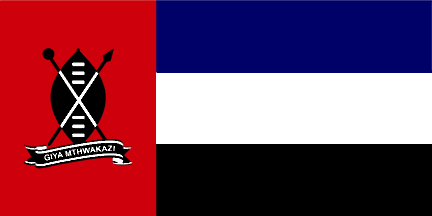 image
by José Manuel Erbez Rodríguez, 29 Nov 2012
image
by José Manuel Erbez Rodríguez, 29 Nov 2012
Mthwakazi Liberation Front (MLF) is serious about prospects of a breakaway state
and have gone a step further by unveiling a proposed national
flag for a conceived Ndebele state. In a recent statement (reported by
www.zimdiaspora.com) the MLF
Secretary-General, Paul Siwela, said the organisation intends to officially
hoist a flag when its plan to form the Mthwakazi nation in 2018 materialises.
He said the flag, which features red, blue, black and white colours in addition
to a shield, spear and a knobkerrie, symbolised the struggle for the
independence of Matabeleland which is now part of south-western Zimbabwe.
“Red stands for the blood of our heroic forefathers who fought many battles to
create our great nation and state resisting colonialism in the 19th century,”
reads the statement.
“It also represents all who died during the war in Rhodesia and those killed by
the Zimbabwe government.”
He said from 1980, Mthwakazi people had suffered much humiliation, genocide,
marginalisation and domination first by the British and now by rival local
ethnic groups.
Siwela said the shield, spear and knobkerrie signified the weapons which were
used by the Matabele State standing army during the 19th century.
“All ethnic groups found in Matabeleland, including the Shona who desire to make
it their permanent home, are entitled to be full citizens of the republic,” he
said.
The meaning of the flag is described in the statement as follows:
Red
The Red stands for the blood of our heroic forefathers who fought many battles
to create our great Nation and State and gallantly fought to resist colonialism
during the later part of the nineteenth century. It also represents all those
who died during the war in Rhodesia and those who were dastardly killed by the
Zimbabwe government for refusing to recognise the Zimbabwe state as is currently
constituted. Since 1980 up to date our people have suffered much humiliation,
genocide, marginalisation and domination first by the British and now by
Zimbabwe. Once more our people stand ready to claim their land and sovereignty
and are ready to sacrifice for such a noble cause and establish the Republic of
Matabeleland.
The Shield, Spear and Knobkerrie
The Matebele state had a standing army that was well above ten thousand by
mid-nineteenth century and all able bodied men above the age of eighteen years
and single were conscripted into the army. The Army was made up of various
battalions and spread throughout the state. It also had the intelligence unit
which had separate command structure from that of the army. The weapons used
were spears and knobkerries and the shield used for cover during the fight. It
was later that guns were incorporated into the military arsenal of the army. The
guns were part of the Rudd Concessions between the British Imperial agents and
King Lobengula. It is worthy to note that the British forces led by
Major-General Frederick Carrington failed to defeat the Matebeles during the
Anglo-Matebele war of 1896 when the British imperial forces were fighting using
the Henry-Martin rifles, maxim guns and machines guns while the Matebele fought
using both the spear, knobkerrie and shield and some regiments fought using the
Henry-Martin rifles. The shield, spear and knobkerrie stands for courage,
stoicism and sacrifice to the Matebele people.
Blue
The Matebele people have the folklore that they descended from the skies and are
children of the stars where there is peace and stability. It was and is still
recognised that the sky is blue and we get our rains from above and that where
there is no water there is no life. So the colour Blue stands for stability,
peace, life and water, whose combination projects progress and development.
White
When the white people arrived in Matebeleland, they were allowed by King
Mzilikazi to marry black women and some married the Kings daughters and when
King Lobengula sent his two envoys to meet Queen Victoria In London in 1888,
Queen Victoria gave the emissaries her necklace and photo to King Lobengula.
That represented mutual trust, co operation and desire to bridges between the
two races. The white colour stands for white people including Arabic and Asiatic
nationals and peace and we believe through mutual respect and co-operation we
can build a better world where both black and white people including other races
i.e Asiatic, Arabic etc can can live in harmony and share the development,
progress, stability and resources together. It is our intention to invite many
white people to come and settle in our new Republic of Matebeleland and help to
build our country and share the resources. We have a beautiful country that is
rich in various natural resources. The white colour also represents peace,
development and progress and its our belief that both black and white people in
future Republic of Matebeleland will develop this state to be the future
Singapore of Africa.
Black
The Black colour represents all people of colour who commit themselves to be
citizens in our Republic. Black colour represents authority, fairness, equality
and justice according to Matabele beliefs. So all ethnic groups found in
Matebeleland including the shona people who reside in Matebeleland and desire to
make it their permanent home are entitled to be full citizens of the Republic
and be entitled to equal opportunities and duties like any other ethnic group
found in Matabeleland Republic. We are aware that not all Shonas hate Matebeles
and not all Shonas like what President Mugabe is doing to the Matebeles.
Furthermore we desire to live side by side in peace with the Republic of
Zimbabwe as our neighbour and co operating with each other in all areas of human
endeavours, and this would include all our neighbours in the region.
José Manuel Erbez Rodríguez, 29 Nov 2012
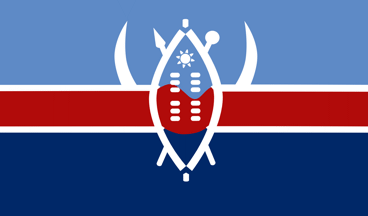 image sent by Theron Maling,
16 Oct 2023
image sent by Theron Maling,
16 Oct 2023
The United African National Council (UANC) was led by Bishop Abel Muzorewa and was the
ruling party in the short-lived Zimbabwe Rhodesia in 1979. Following the banning
of most African-based political parties in Rhodesia in the early 1960s, many
African political leaders were jailed or left the country. Muzorewa initially
led resistance to the Rhodesian Front regime in his pastoral capacity and formed
the UANC to represent African political opinion in opposing the constitutional
proposals negotiated by Ian Smith (for the Rhodesian Government) and Sir Alec
Douglas Hume (for the British Government) in 1971. As an internally based
African leader, Bishop Muzorewa led the UANC into the "Internal Settlement" with
the Rhodesian Government on 03 March 1978 and formed a transitional government
with the Rhodesian Front and other political parties, winning the first
universal adult suffrage elections held in the country in April 1979 with 67% of
the vote. A Government of National Unity was formed under the UANC when the
country became Zimbabwe Rhodesia on 01 June 1979. It was this Government of
National Unity which entered into negotiations with the externally based African
nationalist leaders of the Patriotic Front, led by Robert Mugabe and Joshua
Nkomo, at Lancaster House in London at the end of 1979 and which finally arrived
at an agreement which led to the return to legality of the government of
Zimbabwe Rhodesia. The country returned to a brief period of direct British rule
following the arrival of Governor Christopher Soames on 12 December 1979 whose
task was to monitor the ceasefire, supervise new elections and transfer power to
a new government in terms of the Lancaster House Agreement. This was achieved
when Zimbabwe attained independence on 18 April 1980.
The flag
used by the UANC comprised a red field. In the canton are three horizontal
stripes of black, yellow and green, the colours of the South African
African
National Congress (ANC) - although sometimes not in the same order. A number of variants were seen during the election
campaigns in 1979 and 1980, one of which was unveiled in the town of Gatooma and
photographed by the Pretoria News (28 January 1978). This flag had a red
background with black, green and yellow horizontal stripes in the centre and the
letters UANC in black in each corner.
According to UANC Publicity Secretary at the time, David Mukome, the colours
stood for the following: "The black is for the majority of the people in this
country. Green is for agriculture which is the main occupation of our people.
Yellow is for the minerals in general which are a major
source of our foreign currency" while the red background is for the "blood that
has been shed". These colours were also used in the national flag of
Zimbabwe Rhodesia with similar symbolism. Flagmaster No. 115 (2005)
shows a UANC flag and gives the order of the colours in the canton as being
black, yellow and green. Michael Faul, the author of the article, has since
informed me that he has a hand-held flag given to UANC supporters in 1979 on
which he based his description. It appears that the order of the horizontal
stripes (particularly the yellow and
green stripes) may have differed thus leading to a number of variants of the
UANC flag. This is a photo from The Economist, (12 Jan 2002, page 15) showing
demonstrators in the latest election campaign in Zimbabwe. Can anyone identify
what flag is being flown (and echoed on one man's shirt)?
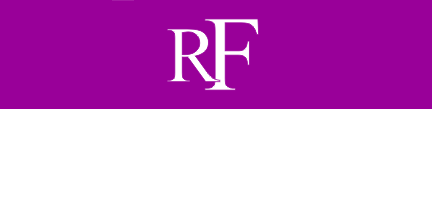 image by Martin Grieve, 31 May 2005
image by Martin Grieve, 31 May 2005
The Special Edition Newsletter published by the Société Française de Vexillologie to commemorate its
20th anniversary illustrates the flag used by the Rhodesian Front. The flag is
divided horizontally purple over white, with the party's "RF" logo in white on
the upper purple stripe. The symbolism of
the colours is unknown.
The
Rhodesian Front was founded in 1962 and was the governing party in what was then
Rhodesia between 1964 and May 1979. Under the leadership of Ian Smith, who
became Prime Minister of Rhodesia on 14 April 1964, Rhodesia declared a
Unilateral Declaration of Independence (UDI) from Britain on 11 November 1965.
This was later declared illegal by the United Nations which imposed mandatory
economic sanctions on the country. The Rhodesian Front advocated that the
government of the country should remain in "responsible hands" and was opposed
to communism and the compulsory integration of Africans and Europeans in
Rhodesia. The party won all 50 "European" seats in the Rhodesian parliament in
1970. Following the "Internal Settlement" between the Rhodesian Government and
internally based African nationalist leaders on 03 March 1978, universal adult
suffrage elections were held at the beginning of 1979 which led to a victory by
the United African National Council (UANC) led by Bishop Abel Muzorewa. Bishop
Muzorewa became Prime Minister of a Government of National Unity, including the
Rhodesian Front, when the country became Zimbabwe Rhodesia on 01 June 1979. It
was this Government of National Unity which entered into negotiations with the
externally based African nationalist leaders of the Patriotic Front, led by
Robert Mugabe and Joshua Nkomo, at Lancaster House in London at the end of 1979 and which
finally arrived at an agreement which led to the return to legality of the
government of Zimbabwe-Rhodesia. The country returned to a brief period of
direct British rule following the arrival of Governor Lord Christopher Soames on
12 December 1979 whose task was to monitor the ceasefire, supervise elections
and transfer power to a new government in terms of the Lancaster House
Agreement.
In terms of
the Lancaster House Agreement, there were 20 seats in the Zimbabwean parliament
specifically reserved for "Europeans". These were held by the Rhodesian Front,
which changed its name to the Republican Front following the independence of
Zimbabwe in April 1980 and later to the Conservative Alliance of Zimbabwe (CAZ).
Ian Smith remained leader of the party until 1987. The reservation of "white"
seats in the Zimbabwean parliament ended in 1990 and the CAZ has since faded
from the political landscape in Zimbabwe.
Bruce Berry, 31 May 2005
United African National Council (UANC)
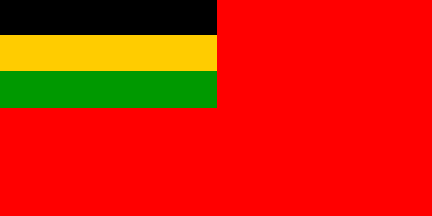 image by
Martin Grieve, 27 May 2005
image by
Martin Grieve, 27 May 2005
In the
February 1980 elections the UANC won three seats in the first Zimbabwean parliament
and remains a small political party with Muzorewa having left politics in 1986.
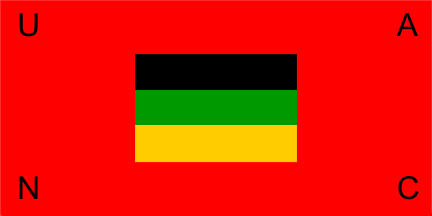 image by
Martin Grieve, 27 May 2005
image by
Martin Grieve, 27 May 2005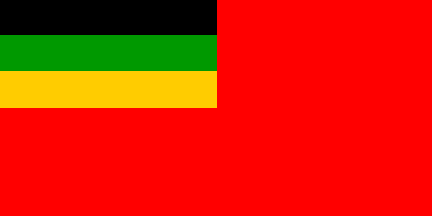 image
by Martin Grieve, 27 May 2005
image
by Martin Grieve, 27 May 2005
Bruce Berry, 27 May 2005
A political UFE
![[ufe]](../images/z/zw}ufe.jpg) image sent by Albert S Kirsch, 17 Jan 2002
image sent by Albert S Kirsch, 17 Jan 2002
Albert S Kirsch, 17 Jan 2002
 image sent by Bruce Berry, 05 Feb 2010 (from website)
image sent by Bruce Berry, 05 Feb 2010 (from website)
The Gunga Political Party of Zimbabwe is a Zimbabwe political party which is
being directed from exile. The Party is committed to developing and
pursuing agendas that include doing all it takes to secure sovereign freedom and
economic prosperity for Zimbabwe. The Party's founding president and chief strategist
is Jayaguru Nyathi (aka Robert Godfrey Musasiwa [Kazembe]. Gunga is a
modification and successor to the Bond Political Party which was formed at the
end of 2000 and beginning of 2001. There are two flags presented on their
website - a
standard flag for the Gunga Home League and the multi-purpose Gunga Rainbow
flag, both of which have the party logo as the central device.
 image sent by Bruce Berry, 05 Feb 2010 (from website)
image sent by Bruce Berry, 05 Feb 2010 (from website)
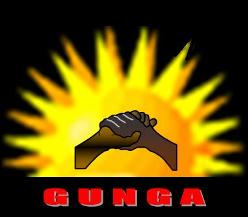 image sent by Bruce Berry, 05 Feb 2010 (from website)
image sent by Bruce Berry, 05 Feb 2010 (from website)
The explanation given for the colours and logo of the party are given as:
The sun background - symbol of light and energy
The raised handshake - symbol of unity
Gunga - in the Shona
language this means many people united to accomplish a pledge or bond/covenant
between them (Imbizo in Ndebele).
Valentin Poposki, 04 Dec 2009